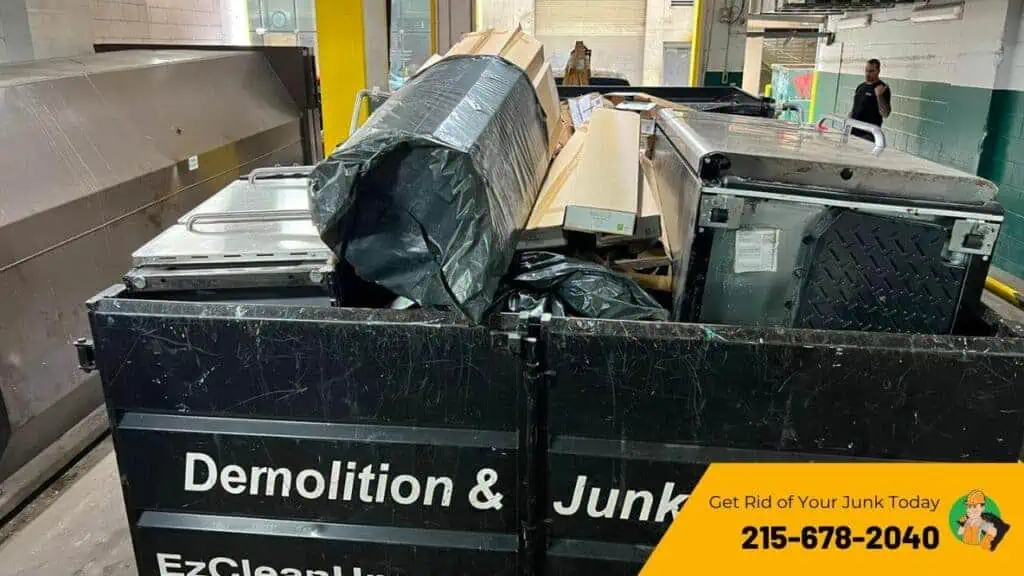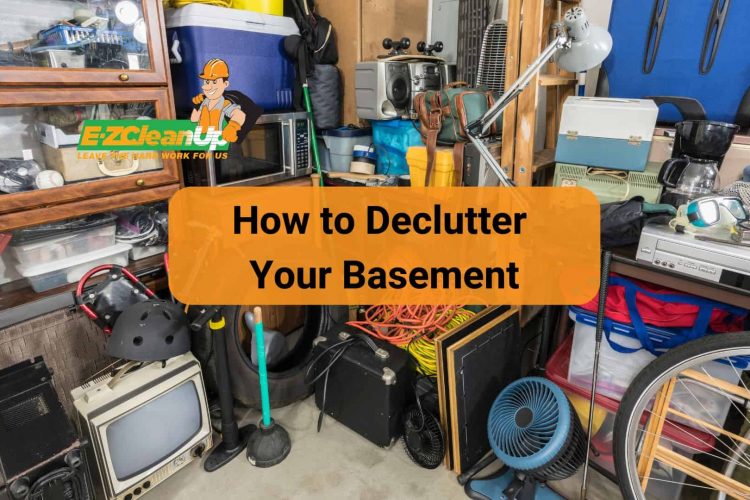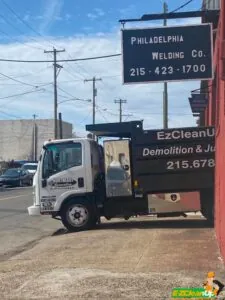Clearing your basement involves setting functional goals, sorting items with the Four-Box Method, and implementing smart storage solutions. Regularly assess item necessity and maintain organization by prioritizing frequently used items and removing clutter systematically.
If you want to learn more about how to declutter your basement, read our article below.
Step #1: Establish Clear Decluttering Goals
Before tackling the clutter in your basement, it’s essential to define what purposes your basement will serve. Whether it’s going to be a storage area, a workshop, a home gym, or a recreational room, knowing its function will guide your decluttering efforts.
Consider how you currently use your basement and how you might want to use it. Is it merely a storage catch-all, or could it double as a functional living space? Decluttering with a purpose in mind helps you make practical decisions about what stays and what goes.

Set Achievable Decluttering Objectives
Start by setting small, manageable goals. For example, you could aim to clear one corner at a time or designate specific days for different types of decluttering activities. Experts recommend using clear bins for easy identification of contents and suggest revisiting your decluttering goals periodically to adjust as needed.
To effectively declutter, consider the 5-second rule: if you haven’t used an item within the last five seconds of thought, it’s probably time to let it go. This method prevents hanging onto items out of a ‘just in case’ mentality, which is crucial in a space like the basement where unused items tend to accumulate.
Additionally, integrating built-in storage solutions can be a game-changer. Utilizing built-in cabinets or shelving units can maximize space and keep your basement organized. Assign cabinets for specific item types—like holiday decorations or sports equipment—to maintain order and ease of access.

Step #2: Sort and Categorize Items
The Four-Box Method simplifies the decluttering process by helping you categorize items into four distinct groups: Keep, Donate, Sell, and Trash. This method encourages decisive action on each item in your basement, preventing the common pitfall of moving clutter from one place to another without making real progress.
- Keep: Items that you use frequently or that have significant emotional or financial value.
- Donate: Items in good condition that you no longer need but could be useful to others. Many charities will even pick up these items from your home, making it easier to part with them.
- Sell: Items that are valuable but no longer needed can be sold to add a bit of cash to your wallet. Consider online marketplaces or garage sales as potential outlets.
- Trash: Items that are broken, worn out, or otherwise unusable should be disposed of responsibly.
Identify Items Not Used in Over a Year
An effective strategy to decide what to keep is the one-year rule. If you haven’t used an item in over a year, it likely doesn’t have a place in your daily life. This rule is particularly useful for assessing the usefulness of miscellaneous or stored items that often accumulate without conscious notice.
Step #3: Implement Efficient Storage Solutions
Maximizing vertical space in your basement or storage areas is essential for creating a functional and organized environment:
- Tall Bookshelves and Cabinetry: These units offer ample storage and can transform unused wall areas into functional spaces. For items you need to access frequently, keep them within arm’s reach, while lesser-used items can be stored higher up.
- Over-the-Door Storage Solutions: Install over-the-door hooks and racks for an easy and efficient storage solution. This method is especially useful in areas where floor space is limited.
- Wall-Mounted Furniture and Hooks: Consider wall-mounted desks in home offices, which provide a workspace without taking up floor space. These often come with additional shelving above the work area.
- Ceiling and Hanging Storage: For homes with high ceilings, utilize ceiling-mounted racks to store items like bicycles and pots, or even create a unique shelving unit for books and decor.
Step #4: Organize Items By Frequency of Use
Place Frequently Used Items Within Easy Reach
For items you use daily or weekly, store them in easy-to-access locations. This could be lower shelves for kitchen items you regularly use or a drawer under your desk for office supplies. Accessibility reduces time spent searching and increases efficiency in your daily routines.
Store Seasonal and Rarely Used Items in Less Accessible Areas
Items that you don’t need on a regular basis, such as seasonal decorations, holiday dishes, or archival documents, should be stored in higher shelves or in less accessible parts of your storage areas. This practice makes better use of your prime storage space for items in frequent rotation.
For very infrequently used items, consider external storage solutions or higher, out-of-the-way spaces in closets or attics.

Step #5: Maintain a Decluttered Basement
Maintaining a decluttered basement is key to ensuring your home remains organized and functional. By setting regular times to organize and clean, you prevent clutter from accumulating.
Experts suggest making decluttering a routine part of your schedule, whether it’s monthly, quarterly, or seasonally, depending on the usage and accumulation of items in your space. Simple tasks like clearing flat surfaces can significantly prevent clutter build-up. Regularly review these areas to keep them neat and functional.
Meanwhile, with the changing seasons, some items in the basement will no longer be in use. Store out-of-season items properly and declutter the ones that are unlikely to be used again.
Apply the One-In, One-Out Rule
This simple principle ensures that for every new item introduced into a space, an old one is removed, promoting balance and preventing clutter from accumulating.
- Initial Decluttering: Begin with a thorough decluttering session to set a manageable baseline of items in your basement. This creates a clear picture of what you own and highlights duplicates or unnecessary items that you can remove immediately.
- Mindful Acquisitions: Each time you consider adding a new item to your basement, think critically about its necessity and the space it will occupy. This rule forces you to evaluate the real value of each addition, curbing impulsive purchases.
- Continuous Assessment: Regularly assess the state of your basement to ensure that each item still deserves its place. This ongoing process helps keep your space organized and functional without periodic, large-scale decluttering efforts.
- Designated Areas: For effective implementation, maintain designated areas for items that are frequently used versus those that are seasonal or infrequently used. This organization makes the one-in, one-out process simpler and more systematic.
- Emotional and Practical Considerations: When deciding which item to remove, consider both its emotional significance and practical utility. Items that are rarely used, outdated, or no longer bring joy are ideal candidates for removal.

Make Basement Decluttering EZ!
Once you’ve decided what stays and what goes in your basement, the actual removal of unwanted items can seem challenging. Whether it’s old furniture, boxes of unused possessions, or outdated electronics, EZ CleanUp can turn your decluttering resolutions into reality.
We take over where your sorting efforts end by handling the disposal and recycling of your discarded items responsibly. Reach out and see how we can help make your basement decluttering hassle-free.













